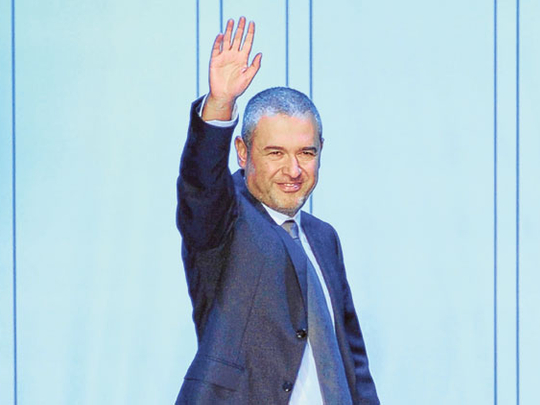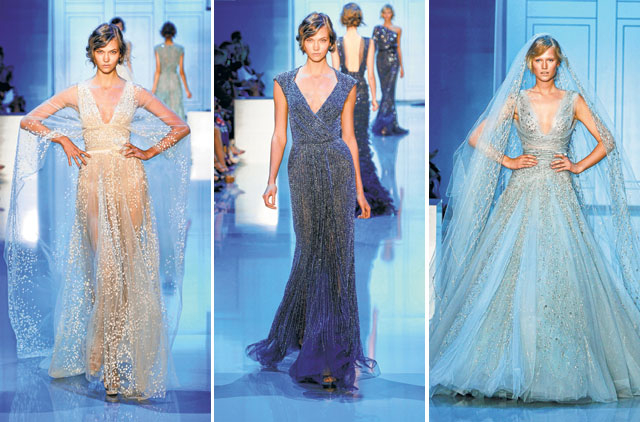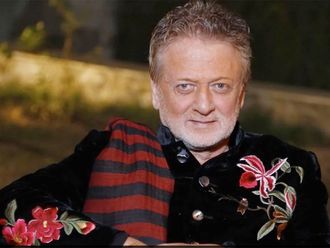
Don't take risks. Don't be shocking. Live simple."
In this age of Lady Gaga, Elie Saab's fashion advice seems, well, almost shocking in its austerity. The man who launched a thousand Swarovski-swamped impersonators is telling me that he isn't impressed by celebrities who take fashion to extreme levels - and while there are many who would accuse Saab of instigating the current crop of OTT Arabic designers, a quick glance at his latest haute couture offerings, as always, reveals why he is considered a master of the art: a rare subtlety along with the sequins.
"Why would she want to be crazy?" continues Saab, seated in the cool white surroundings of the Pavillion Downtown Dubai gallery recently. He's reacting to the suggestion that the current red carpet scene is predictable and lacking in risk takers. "She" is the woman, his raison d'etre, the feminine ideal he lives to dress. "In some places, I feel like she's confused, she doesn't have enough to live in simple ways. She wants to be shocking. For me it's not healthy."
The Lebanese designer has never hidden the fact that he has one main objective: to make women beautiful. "I don't like women who take risks. Because for me, the more important thing for a woman is that she respects her femininity and her image. To be a fashion victim — for what? It's complicating life for nothing."
This month, a different outlet for that objective was released: his long-awaited first fragrance, Elie Saab Le Parfum, the first of what he promises are many lifestyle extensions to his brand.
"For me [a fragrance] is very important because it's complementary to a couture house. We are doing a lot for lifestyle. We have a lot coming up. We are serious about too many projects."
Saab turned to Beaute Prestige International, the cosmetics company behind several iconic fashion label fragrances — think Issey Miyake, Narcisco Rodriguez — to create the scent, saying the process was too far away from his world of tulle and taffeta.
"It's not the same way as [doing] fashion, it's not the same feel. It's more industrial. It's not my market. I want to leave my feeling and my approach for the women I respect." To that end, a concoction by reknowned "nose" Francis Kurkdijan (the creator of Jean Paul Gaultier's Le Male) was picked from dozens of others put forward for development.
"It was easy," says Kurkdijan of working with Saab. "Because we are speaking a common language, mostly because of my origin [France-born Kurkdijan is of Armenian origin], also because I see myself as a mix between East and West, and I do believe he feels also that way. His brief was: ‘Get my style and get my spirit into a bottle'."
Respect for a woman
That spirit, adds Saab, is "a big responsibility." It's "respect for a woman to wear something always flattering from me." Looking up from a photograph of Bollywood actress Aishwarya Rai Bachchan wearing one of his designs on the red carpet at the Cannes Film Festival, he adds: "The woman everywhere speaks the same language. She wants to be beautiful. Just because she's Indian, African, American — she wants to be beautiful. From my side, this is my obsession, always. I don't go far, I don't want to do stories. I want to do clothes flattering for a woman only. It's my target."
That's not his only target however: having the fashion world take his home country seriously, and having the Lebanese take their own fashion designers seriously, have been parallel projects for over two decades.
"My atelier is in Lebanon," he says when asked why he doesn't move to Paris. "All my haute couture is there. I don't want to move. I have my people for 25 years. I'm so proud of the image of my country and I'm a success story of all the Arabic countries."
Plenty of the rising stars of Lebanese design — including Rabih Kayrouz, who also showed at Paris Haute Couture Week last week — worked under Saab, and most namecheck the designer when asked about why they went into the industry. Saab believes he paved the way not only for Lebanon to be seen as a creative hub, but also for design hopefuls to gain the approval of their families.
"I'm so proud that 80 per cent of Lebanese designers passed through my atelier. For 20 years I've been working on it. I take behind me all these young people, and every time I see a name dressed outside of Lebanon [wearing a Lebanese designer], I feel proud. Trust me — every day I'm working on that. I shocked my parents. Now, every family wants to have an Elie Saab in their family."









